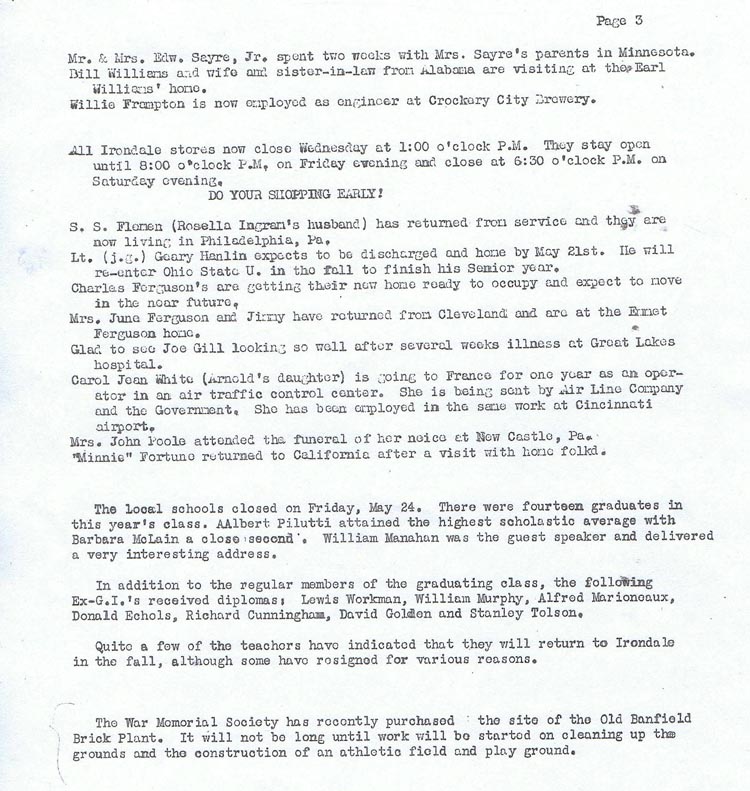
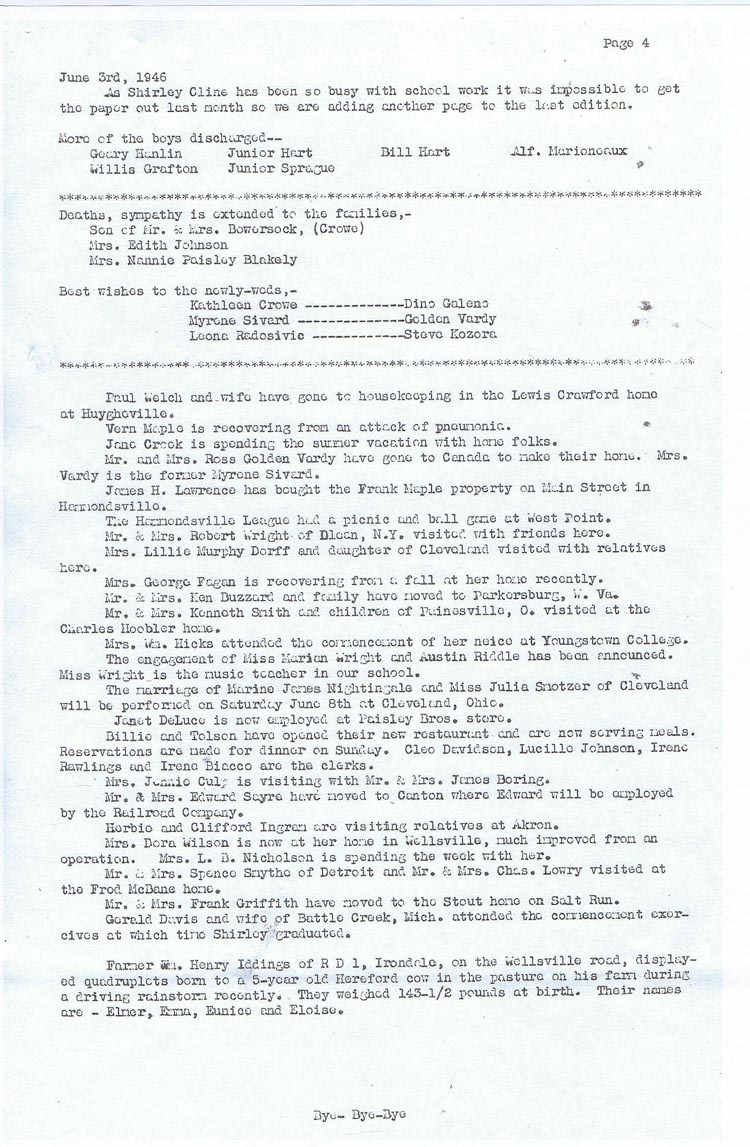
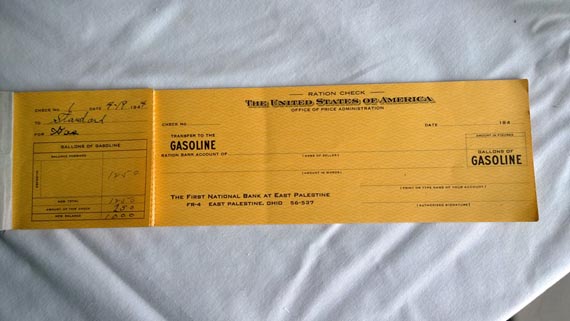
Women in war. Filling station attendant. Tires need checking too? Shifting trends of employment in wartime America have opened up new jobs for such women as this young East Liverpool, Ohio, girl who has pioneered in two new fields since graduation from high school. She learned butchering first, and built up quite a reputation as a purveyor of choice cuts. Now she's one of the most efficient service station attendants in the neighborhood. Her name? Virginia Excell.
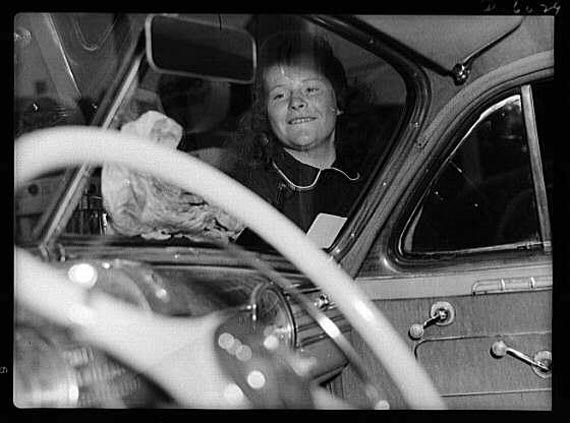
A local version of Rosy the Riveter
Library of Congress Collection: America from the Great Depression to World War II: Black-and-White Photographs from the FSA-OWI, 1935-1945.
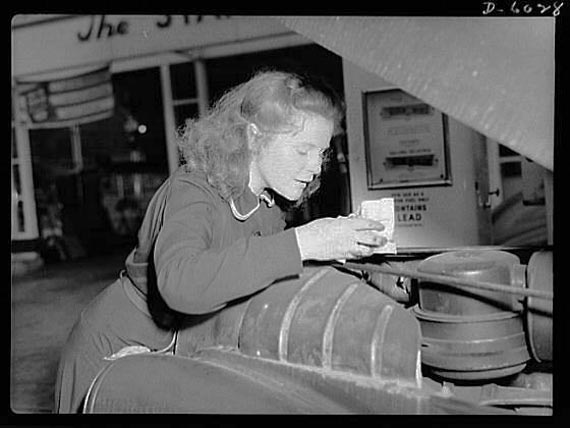
There isn't enough space to mention and honor all men and women who were in the military from ELO and the local area here. We will post a few and they will be representative of the whole. The Facebook site listed below contains pictures of a large number of those men and women along with, in some instances, stories about them or personal reflections..
Military Memories East Liverpool & Tri-state area. Those who served, their friends, families & admirers
https://www.facebook.com/groups/394005590708753/
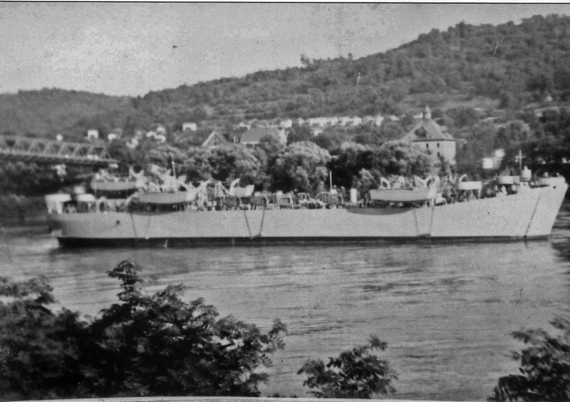
A typical sight on the Ohio River during WWII
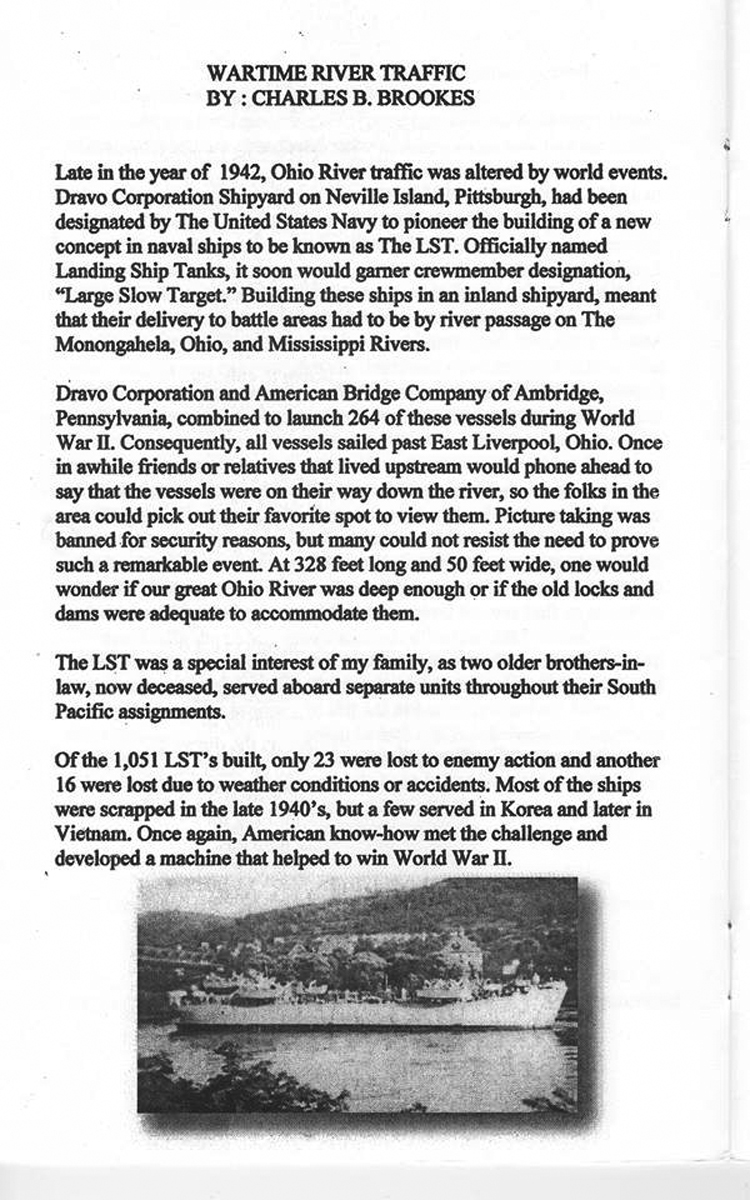
Recognition no one wanted.
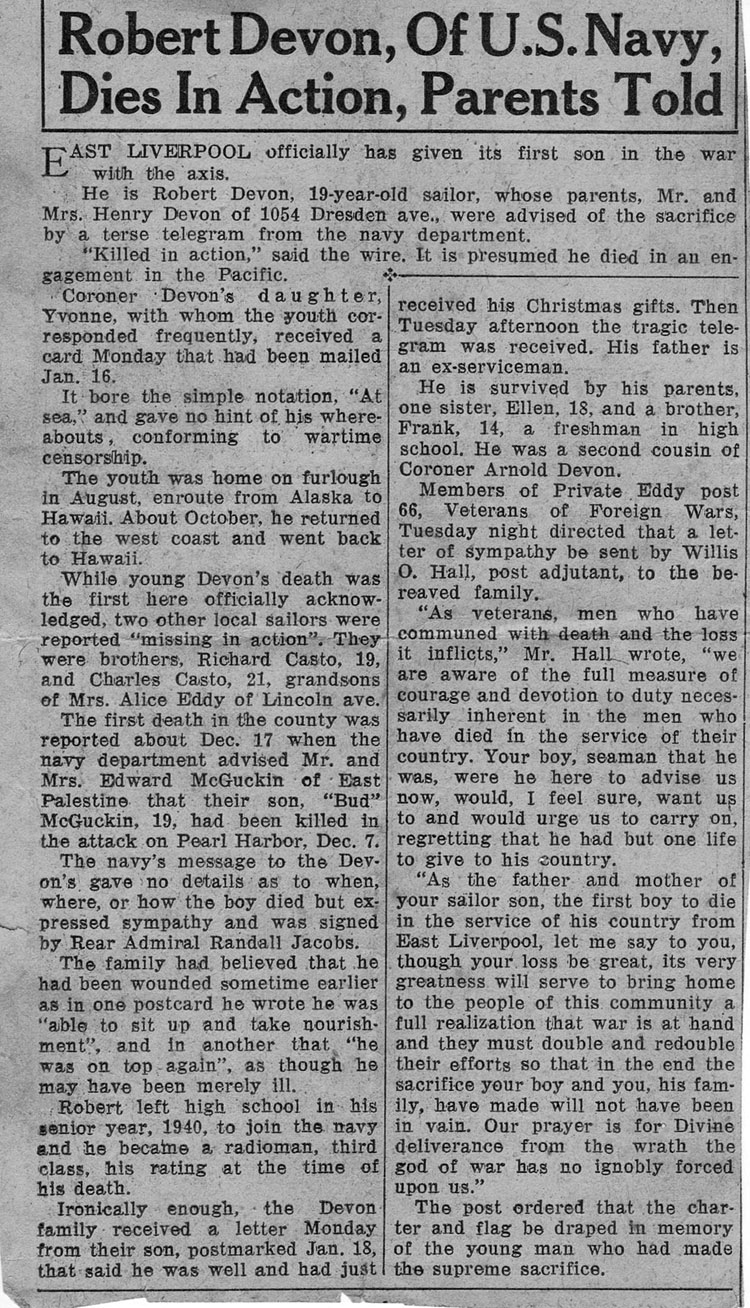
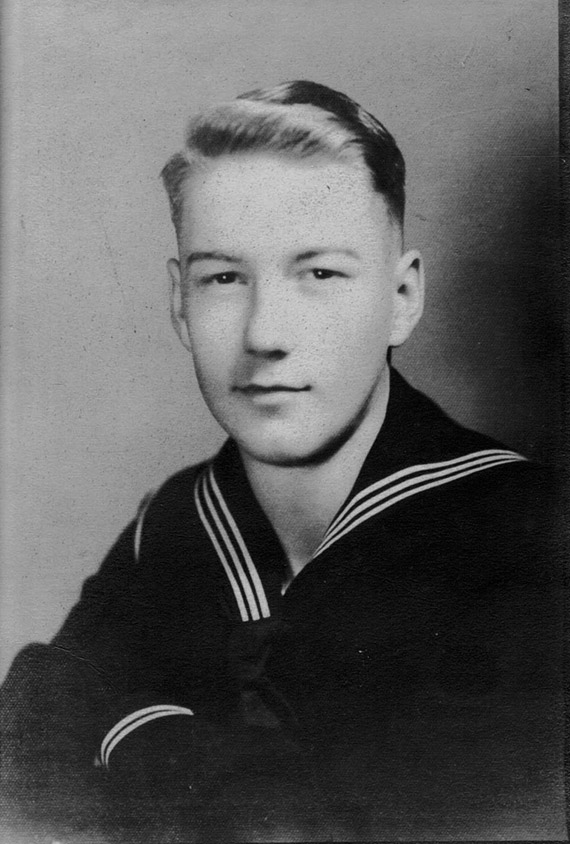
Robert Devon
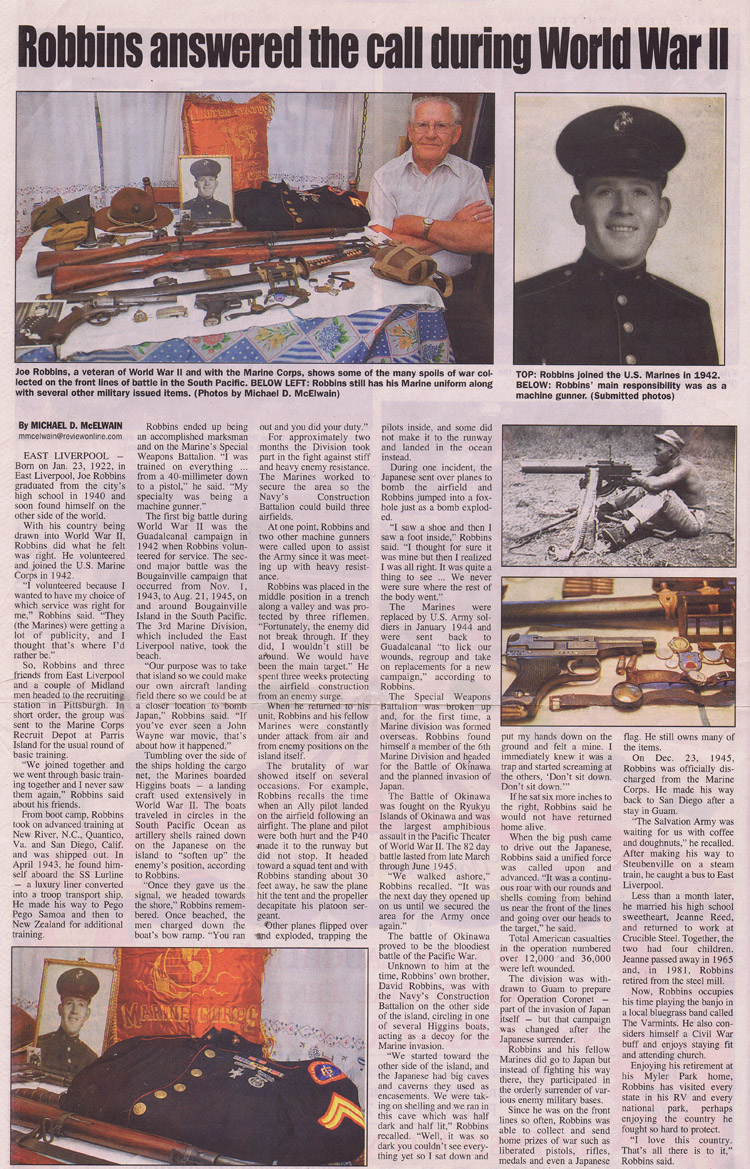

Timothy Brookes on Military Memories East Liverpool & Tri-state area. Those who served, their. . . July 12, 2013 wrote: Bill Sutherland, who just passed a few months ago, was part of the crew of the Yorktown when she sank. His next assignment, the USS Hornet, was also sunk in action.
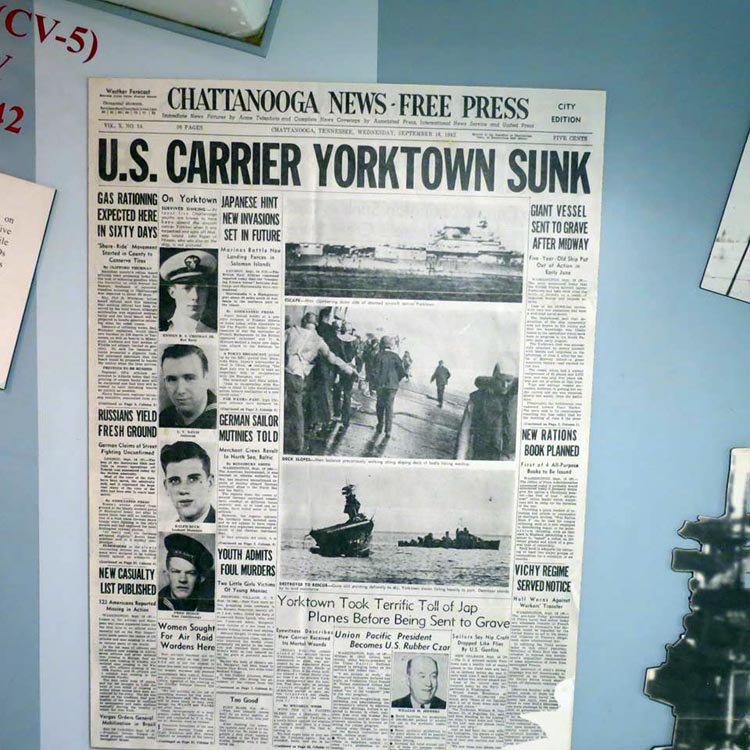
USS YORKTOWN CV-5 was sunk at the Battle of Midway, in June 1942. A new Essex Class Aircraft Carrier was under construction and was going to be named the Bon Homme Richard. The name was changed and the new Essex Class Carrier became the USS YORKTOWN CV-10 in honor of CV-5.
George Jackie Craft on Military Memories East Liverpool & Tri-state area. Those who served, their July 31, 2013 wrote: I found this article in a newspaper my father had saved regarding the return of Harry McCord's remains from a foreign burial after WWII. I had noticed that Mr. McCord had been missed on other lists of East Liverpool citizens who had given their lives during the war. This was from the December 2, 1947 edition of the East Liverpool Review. Unfortunately he did not save, that I have found, the page 6 continuation of the article. My father was raised in the Maplewood area and was good friends with him.
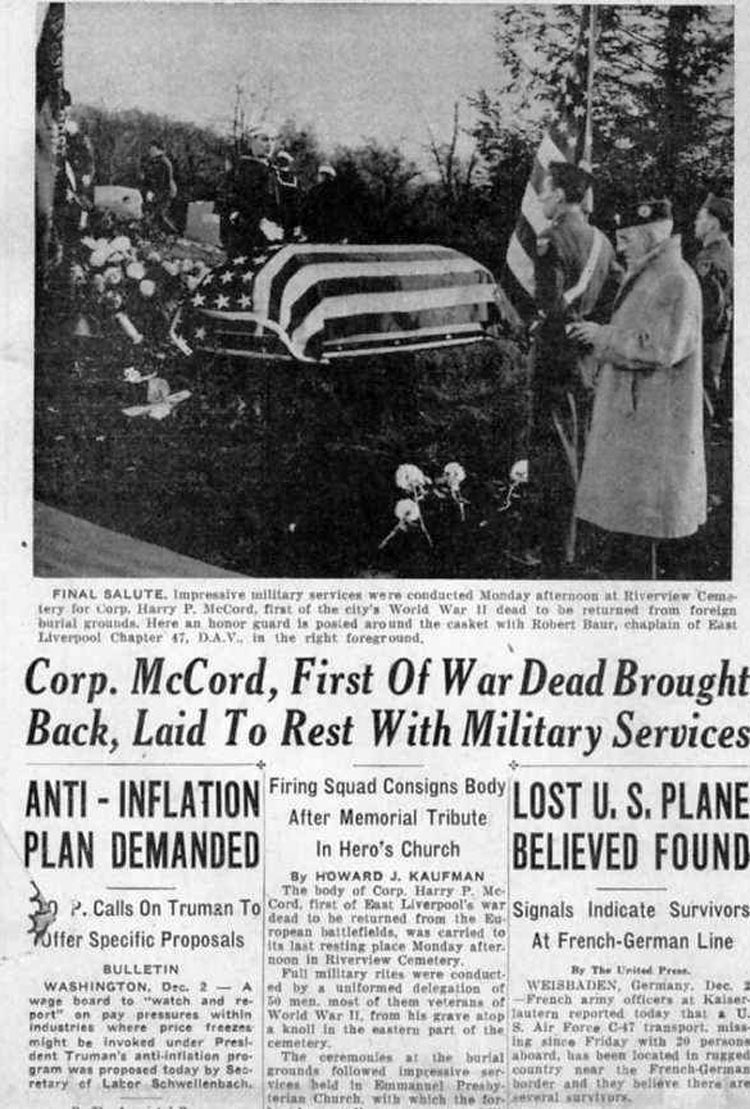

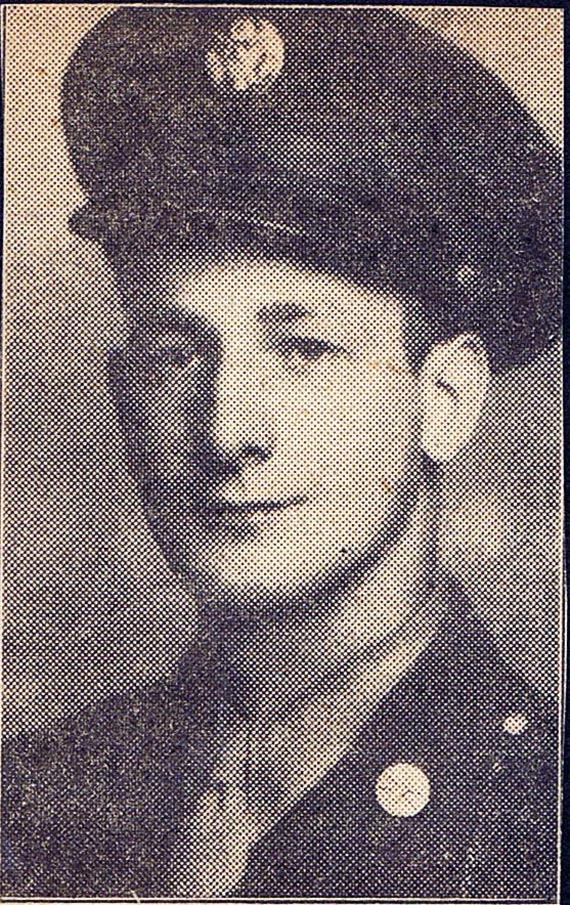
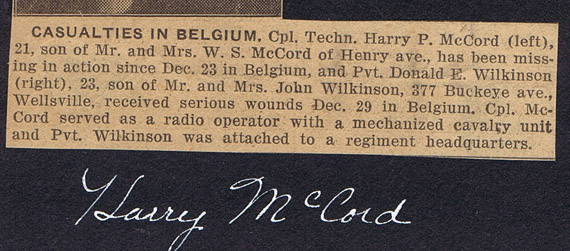
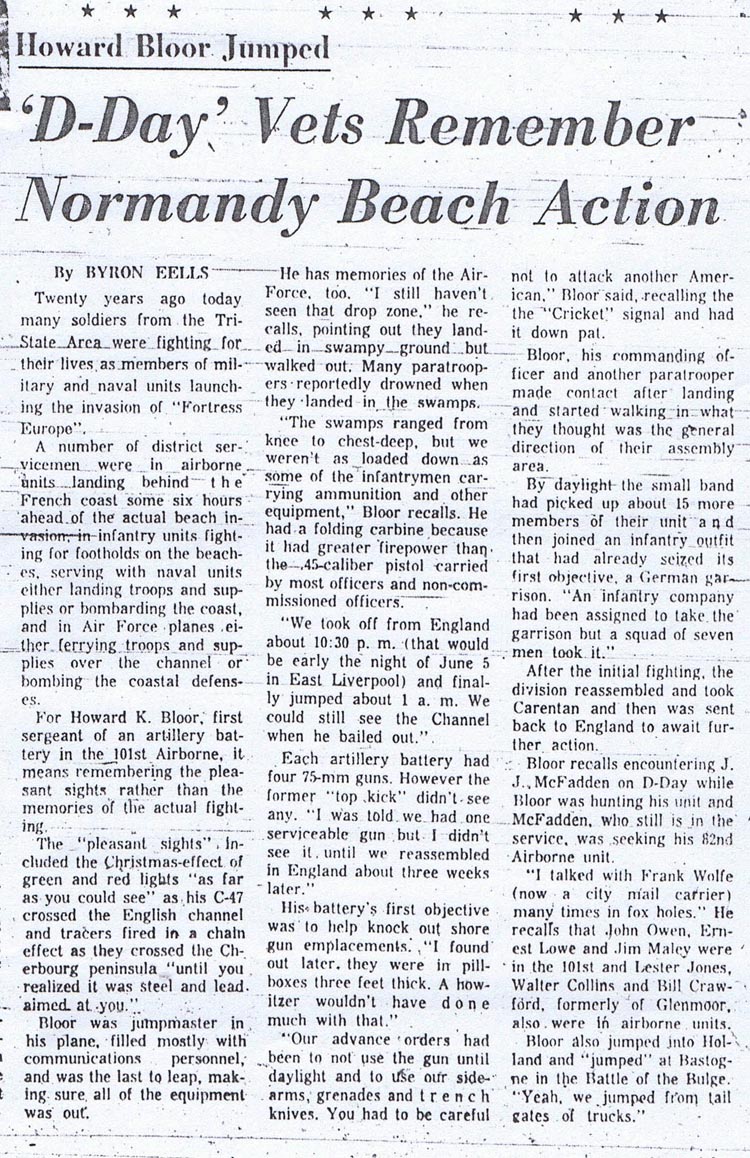
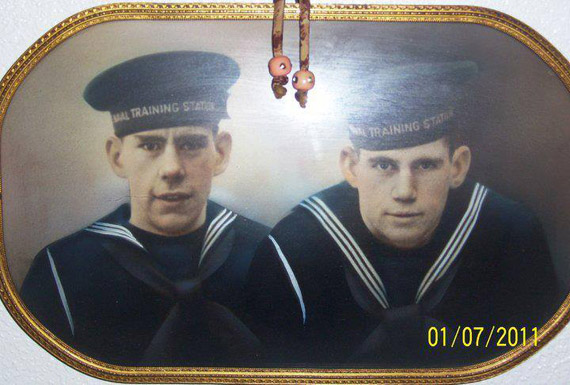
Charles Thompson Posted: This is a photo of my Uncles Bob and Jim Thompson. They served aboard the USS Saratoga during WWII. They were one of the reasons why I decided to go to the Navy. Always thought of them as heroes
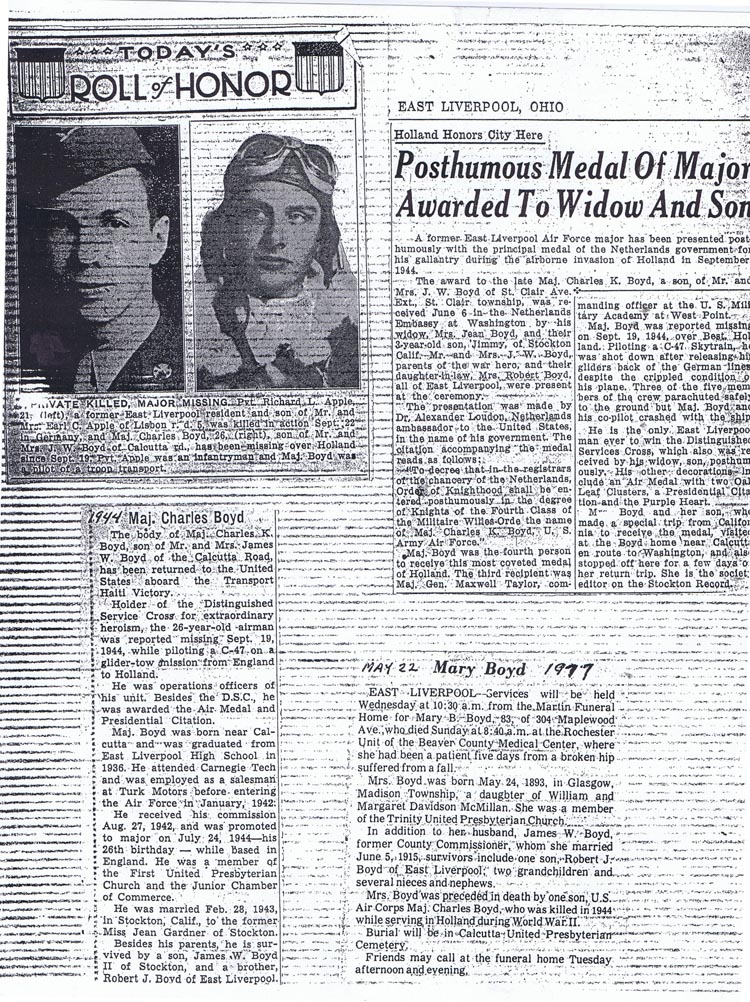
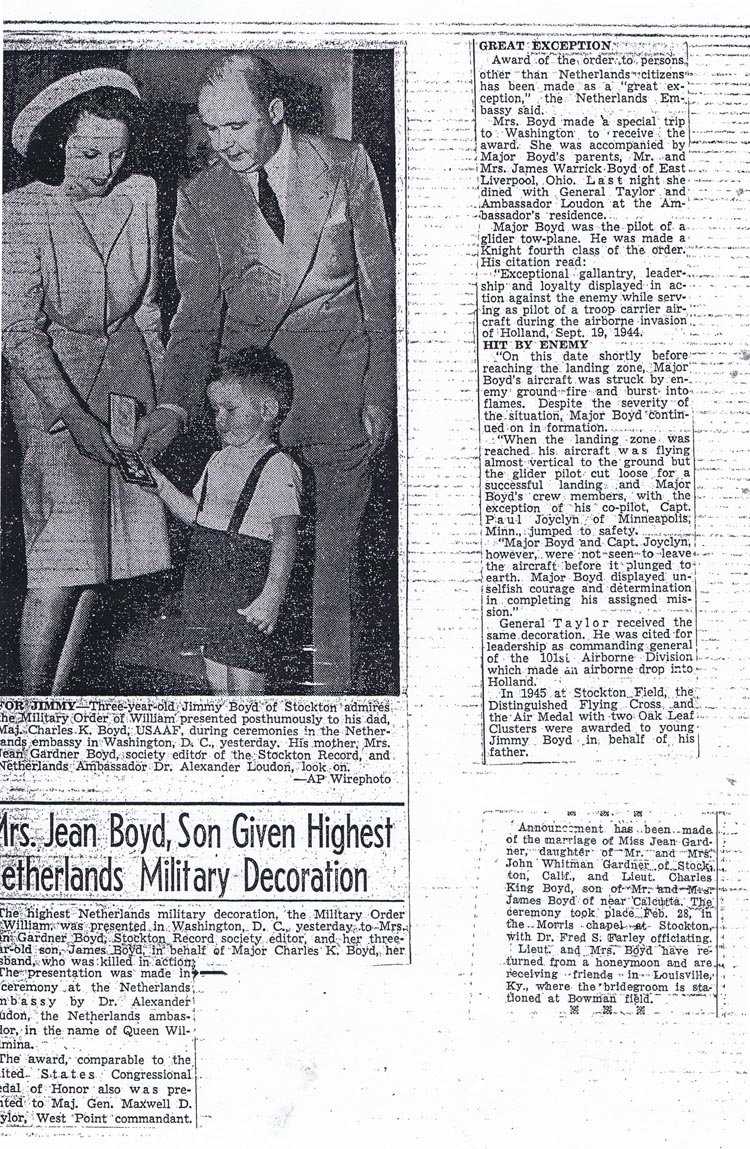
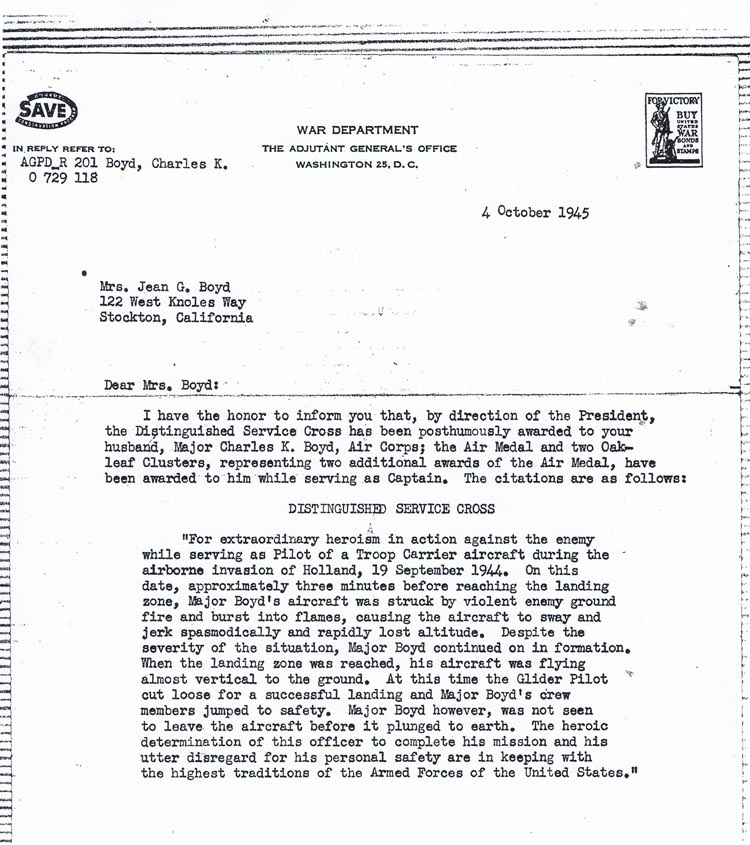
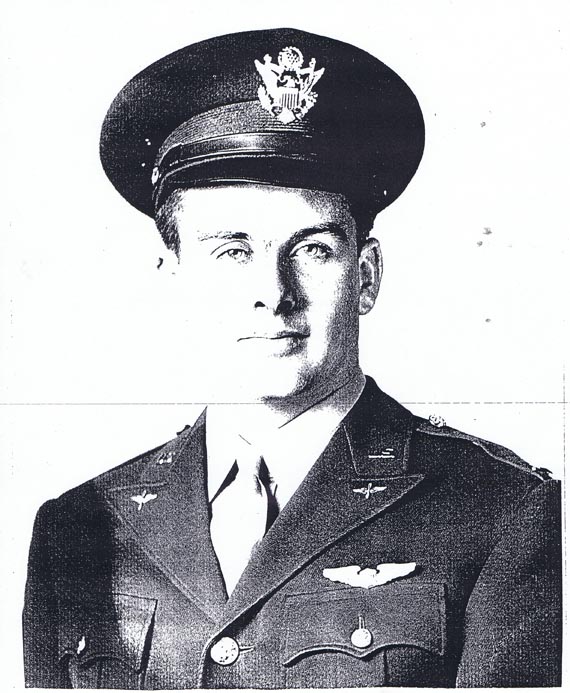
We will meet up again with the Aleutians and Adak, Alaska in the Cold War Section
https://archive.org/details/ReportFromTheAleutians
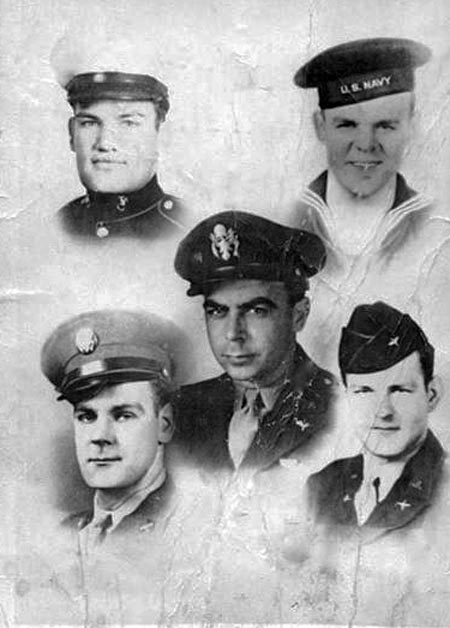
This is a re post of Karenann Keuper Duffy's post. Isn't this wonderful?! This photo hung in my grandmother & grandfather's (James and Kathryn Geon Duffy) home. It shows my Daddy and his brothers and his brother-in-law in their military uniforms during WWII. I have loved this photo since I was a little girl. I'm so very proud of each of them. Courtesy of Nancy Durst Atkins.
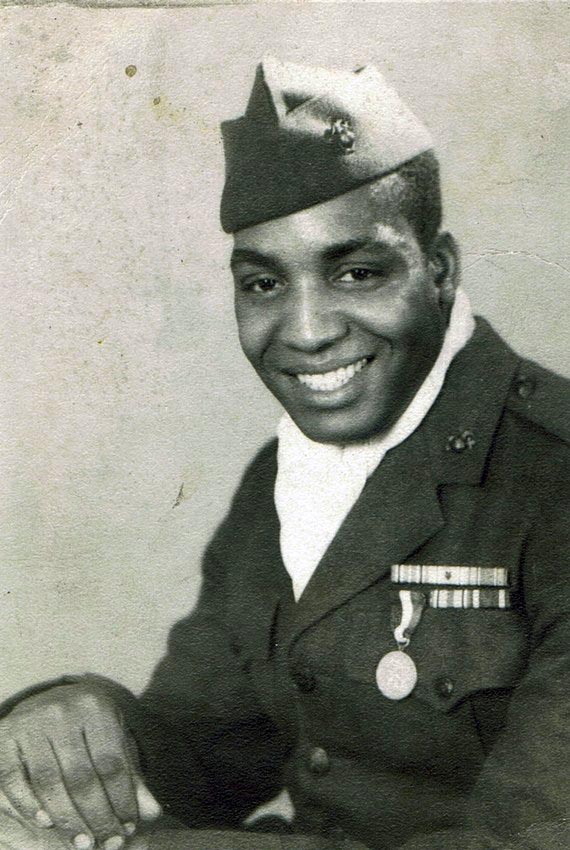
John Bell joined the military on December 3, 1943 after his Junior year in High School. Picture courtesy of Jeannette Bell from the Bell Family Collection.
A hero’s tombstone needed, March 13, 2014, By STEPHEN HUBA - Hancock County Reporter (shuba@reviewonline.com) , The Review
http://www.reviewonline.com/page/content.detail/id/572617/A-hero-s-tombstone-needed.html?nav=5008
Charles Clendenning's Scrapbook A former resident of Klondyke , Charles Clendenning has given us permission to post anything we want from his father’s WWII scrapbook. It is better to just post the URL for the site and let all look at it as they want.
http://www.flickr.com/photos/21952092@N02/sets/72157621934697929/
William J Burlingame on Military on Memories East Liverpool & Tri-state area. Those who served, their December 26, 2013 wrote:
Cecile Boyd Bennett, the daughter of my maternal grandfather's brother. She served during WWII.Her family lived in Dixonville.

Women in War & Military
http://www.eastliverpoolhistoricalsociety.org/woinwar.htm
http://www.eastliverpoolhistoricalsociety.org/wommilt.htm
August 19, 2013 · She was retired as a Registered Nurse and Certified Registered Anesthetist from the Ohio Valley Hospital of Steubenville and was a WW II veteran serving her country as a Captain in the U.S. Army 100th General Hospital Unit in France. She participated in the Battle of the Bulge during her service in Europe. http://www.reviewonline.com/page/content.detail/id/568489/Ona-Wallace.html?nav=5009
ELO WWII Servicemen Killed in Action
http://www.eastliverpoolhistoricalsociety.org/ELO%20WWII%20Servicemen%20KIA.htm
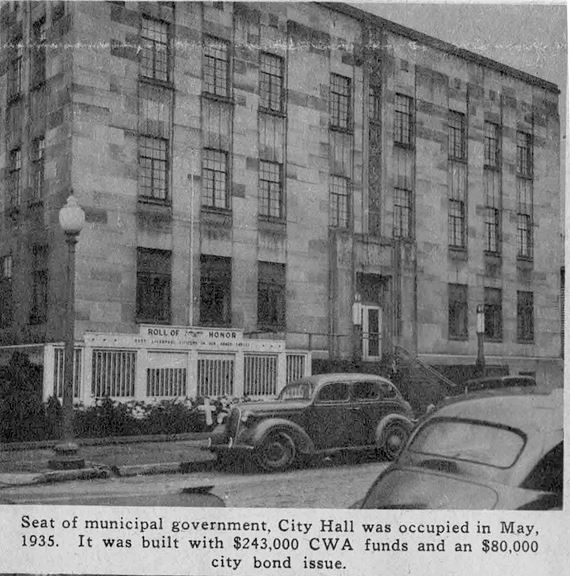
The original Role of Honor in downtown East Liverpool. It probably contained the names of those from WWI, WWII and maybe the Korean War.
Personal Stories
https://www.youtube.com/watch?v=7wSUMbvfJZE
L.M.
When my father left home during WW II.
Exactly 70 years ago from today's date of March 3rd my father, at age 27, left home to begin two years of military service. The process had begun a month earlier when he reported to East Liverpool City Hall 2-2-44 prior to his pre-induction physical in Cleveland. On 2-11-44 the local Review printed a long list of those who passed their physical and were awaiting assignment. Among them were four friends who would eventually face the horrors of combat during WW II. My father, trench foot, and Wayne Barnard, head injury, returned home but two lives were lost. Gene Schneidmiller and Earl Olmstead were both killed in action.
My mother's first letter followed her return home from Steubenville. "I don't know what to say or where to start but honey, without a doubt, this has been the most miserable day of my life." Their initial correspondence was only the beginning of mutual torment which would continue for two long years. Their further exchange of letters throughout the war revealed the anguish and day to day struggle which became typical of families separated by the affects of WW II.
It was 3-3-44 when my father again reported to the third floor of City Hall at 7:30 am before leaving for the train station in Steubenville. From there it was on to the induction center at Fort Benjamin Harrison in suburban Lawrence, Indiana, northeast of Indianapolis. His first letter to my mother the following day included the following: "I will always see that picture in my mind of little Larry waving goodbye and you in tears. I couldn't help but looking back until you were out of sight."
My mother's first letter followed her return home from Steubenville. "I don't know what to say or where to start but honey, without a doubt, this has been the most miserable day of my life." Their initial correspondence was only the beginning of mutual torment which would continue for two long years. Their further exchange of letters throughout the war revealed the anguish and day to day struggle which became typical of families separated by the affects of WW II.
On March 4th my mother includes the following: "I have a picture of you right in front of us. I don't know how I am going to continue, every hour gets worse and I can't get myself adjusted to anything. I get to feeling better and Larry says or does something and then I am back where I started. Larry wants me to sit and hold him all the time."
In my father's letter of March 5th he writes: "Lord, I would like to see old Lisbon hill and walk up and down a few times with you holding one hand and Larry the other." (He refers to Lisbon Street which connects Pleasant Heights with the West End.)
My mother's letter March 6th: "It's hard getting Larry to bed and last night was his worst......Little Larry is so bewildered he doesn't know what to do between missing you and his teeth bothering him and my nerves being upset."
On 3-11-44 my father left Indiana on a troop train of undisclosed destination before arriving at Fort Wolters, Texas to begin basic training. Located 4 miles northeast of Mineral Wells, it was the biggest infantry training center in the United States. The age of his induction into the army compared to mine at 21 indicates the severity of WW II. Through his employment at Hall China he was eligible for a deferment but turned it down as a matter of conscience. Patriotism on the home front was intense and he felt it impossible to remain at home when so many others were away involved in the war effort.
I was a year and nine months old at the time of my parent's separation and too young to understand my father's sudden and prolonged absence. Our upstairs apartment at the home of my father's parents on West 8th Street held too many reminders of his absence and we eventually moved in with my mother's parents on Pleasant Heights. I was only complicating our adjustment and it reached such a point of concern that my mother's father took a week off from the fire department in an attempt to ease my grief and give my mother some relief. She not only had her own emotions to deal with but mine as well and yet in future letters she wrote that without me she wondered if she would have had the will to carry on.
It seems ironic that in this same March time frame 22 years later, I had reached my final days in Vietnam before returning home 3-13-66. My father was drafted into the army 3-3-44 and I was drafted 3-17-64. Having read all of my parents war letters I am in awe of their sacrifice and my mother's unrelenting devotion to both me and my father. Their experiences in written form provide a historic open window into the past.
Jim Taylor, October 23, 2013 · Martinsburg, WV
My father, Ted Taylor, wrote a document about his early life called Life During the Depression and Tales of the Civil War...the following is a short excerpt from the end that concerns his WWII service:
"...Rationing came quickly, gasoline, coffee, meat, poultry, sugar, tires, were all rationed and price controls began. Dad's little station had no chance, so it was sold and we returned to the house in East Liverpool. The mill was going full blast and Dad got promoted to the position of melter, the highest rated job in the open hearth. He was responsible for the quality of steel produced on his shift. For the first time it seemed that money would be no problem. In August 1942 Dad (Charles Leslie Taylor) came home from the midnight shift, he said he wasn't feeling well. The doctor was called and he came to the house and said Dad had the flu. Two hours later Dad died of a heart attack. Our world turned upside-down. Dad had very little insurance and social security was in its infancy. The car went, the telephone was taken out. Mom's income from social security was about $55.00 or $60.00 per month. The rent was $22.00 per month, and then there was coal, water, taxes, electricity: but most of all the food for four growing boys. I don't know how Mom made it: she had no help except Aunt Jean who lived with us and paid $5.00 per week for room and board.
I wanted to go to the Navy; in the spring of 1943 I registered for the draft. When my questionnaire came, Mom had a fit. She was not going to let me go, but Uncle Raymond (Taylor) convinced her that it would do me good, and besides, he said I would not stay, that I would indeed be home in a few weeks, so Mom let me go.
On September 6, 1943 I was "drafted", I passed my physical at Akron, Ohio and was sworn into the Navy. But, it was funny. The group of men I was with had finished the physicals and we were lined up in our birthday suits in alphabetical order, of course. I stood there, over six feet tall, weighed about 125 pounds, skinny as a jay hawk, my ears protruded from my head like wings, my feet like huge boxes on sticks for legs, and my hands like hams on the thinnest of arms, and here I stood between two ‘Charles Atlas’ type men. As we waited in line a Marine Sergeant came into the room, he was in full dress blues, he had rows of gold on his sleeves, and many, many campaign ribbons on his chest. Then he began, “The Marines need one more good man and there is only one more man from Columbiana County good enough to be a Marine. That man is Taylor.” He worked his way down the line and stopped at the guy next to me, “Are you Taylor?” The man shook his head “no.” He then went to the man on my right, “Are you Taylor?” he asked. The man shook his head “no.” He looked at me in dismay, his jaw sagged, his voice barely squeaked, “Are you Taylor?” When I shook my head “yes” he muttered, “You don't want to be a Marine do you?” And I squeaked a very high pitched “no.” The sergeant turned on his heel and marched away. And I was sworn into the Navy, I was going to be a sailor.
I reported to boot camp, the draft I was with was split up and I reported to a group from Michigan. I knew no one. As the company was marched into Camp Green Bay we were greeted loudly by those who had been in boot camp for a few weeks: “New Boots! New Boots!” they screamed. “Needle Bait! Needle Bait!” That was followed up by, “Wait till you get that square needle in the left nut.” All new corners were greeted in the same way. Then when you completed boot training you were taunted with, “Shark Bait! Shark Bait!” as you marched away for your new assignment.
Boot camp was a true experience. Some men cried at night, I did not; some men hated the food. I loved it and wanted more; some men passed out when they got their shots, I did not flinch; some men could not watch as they took their blood tests, I could care less; some men dreaded the thought of going to sea, I could not wait; some men hated where they were, I loved it--I was in the Navy.
About six or seven weeks after we first went to boot camp they had us dress in our blues, then took us to the canteen where we lined up and had our pictures taken. That night when I wrote to Mom, I began: ‘Dear Mom, Wait till you see me in my dress blues ‘
I remained in the Navy for two years and spent fifteen months at sea serving on the USS LSM 147. Our sea duty included about nine months as a training ship operating in the Atlantic and six months in the South Pacific where we were used as a supply ship.
I returned to the States after the war and was given an Honorable Discharge; the reason: I was still sixteen and not old enough to serve in the Navy. After my discharge I returned home and entered high school where I graduated after one year then entered Findlay College as the youngest freshman at the age of seventeen.
Jim Taylor wrote: I forgot I had this photo...shows how different the times were in 1943: who would believe this boy was 18 years old??? This is my father, Ted Taylor, at the reception station when he entered the Navy...BTW he was 14
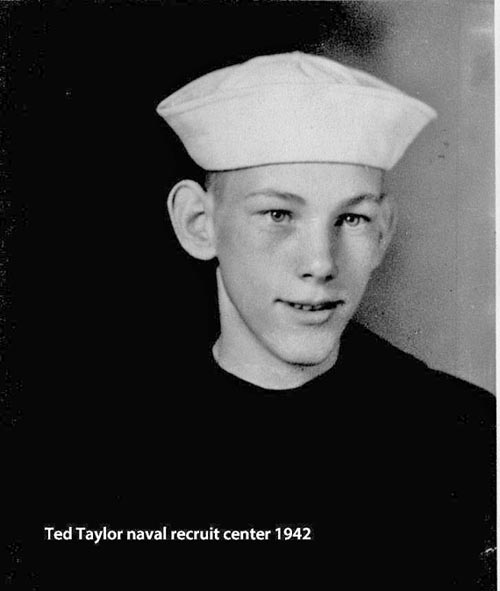
BTW Ted Taylor was the Principle at Beaver Local in the 1970's
The Passing of the "Greatest Generation
http://www.nationalww2museum.org/honor/wwii-veterans-statistics.html
A local well known historian, probably the only local victim of the Atomic Bomb that was dropped on Nagasaki, Japan
EAST LIVERPOOL - Jack A. Lanam, 63, of Windsor Drive died at 9 a.m. Tuesday, Aug. 1, 1989, at home following a brief illness. Lanam served in the U.S Marine Corps in World War II, saw action on Saipan, Tinian and Okinawa, and was among the first troops to enter Nagasaki following the dropping of the A-bomb.
[The first American troops lbeganoccupying in Japan on August 28, 1945. Among those troops was the Unit Jack Lanam was a mmemberof and they entered Nagasaki just a couple weeks after the Atomic Bomb was dropped there. Ultimately, almost every member of that unit, including Mr. Lanam died of cancer as a result of the radiation they were exposed to while in Nagasaki -- ELHS webmaster].
Mr. Lanam was one of the best known and most dedicated local historians in the Tri-State Area and meant so much to East Liverpool and Columbiana County.
Honored in 1980 by the Ohio Historical Society for "extraordinary" efforts in assisting the establishment of the Museum of Ceramics, he was made a life member of the Ohio Society, and was presented the Outstanding Individual Achievement Award by the Ohio Historical Society in 1982.
A lifelong enthusiast for the history of this area and a leader in its preservation, Mr. Lanam served at various times as curator, trustee and treasurer of the East Liverpool Historical Society. He was a member of the Wellsville Historical Society and played a leading part in the restoration of the Church of the Ascension.
Mr. Lanam was a member and former president of the Columbiana County Historical Society. A former member of the Aboriginal Explorer's Club, he also was a member of the Forests and Parks Council.
He organized the Sandy-Beaver Canal Association, the restoration of Lock 36 and the Point of Beginning Celebration based on the Land Ordinance of 1785.
Mr. Lanam was a frequent public speaker on historical topics including the canal, Rock Springs Park, the Point of Beginning and local Indian archaeology.

WE WILL FINISH OUT OUR WWII SECTION WITH THIS
This is not about a song, whether it may or may not be a perversion of Taps or a new version or the original version of Taps or not. It is about a story and about a local people and the respect they show 8301 American Soldiers who died liberating Holland in WWII. I cannot say for certain that there are any American soldiers buried there from our Tri-State area, but I can say that since there are 8301 American Soldiers buried there, there is a good chance that there are at least one from the tri-state area buried there.
READ THE TEXT BEFORE LISTENING TO AND WATCHING THE VIDEO.
In the Netherlands American Cemetery & Memorial in the village of Margraten, about 6 miles from Maastricht there lie buried 8,301 American soldiers killed in the battles to liberate Holland in the fall & winter of 1944-5. Sgt. Bill Dukeman, 101st Airborne Division, 506th Parachute Infantry Regiment, Second Battalion, Company C (of "Band of Brothers fame) is buried there.
He was killed in the battle of "The Crossroads" in northern Holland. The Dutch hold an annual memorial concert every September at the above cemetery to remember & honor the Americans who died to free them in Operation Market Garden & subsequent efforts to eject the German army from Holland. Sgt. Dukeman, like many other fallen GIs, was "adopted" by a Dutch family. Dukeman's family in the States was contacted and hosted in Holland, & his grave site decorated each year by his Dutch "family." They keep his portrait in their home, displayed in a place of honor. Fathers pass this obligation down to their sons in Holland.
Operation Market Garden "Il Silenzio" (The Silence)
About six miles from Maastricht, in the Netherlands lie buried 8,301 American soldiers who died in "Operation Market Garden" in the battles to liberate Holland in the fall and winter of 1944-5. Every one of the men buried in the cemetery, as well as those in the Canadian and British military cemeteries has been adopted by a Dutch family who mind the grave, decorate, and keep alive the memory of the soldier they have adopted. It is even the custom to keep a portrait of "their" American soldier in a place of honor in their home. Annually on "Liberation Day" Memorial Services are held for "the men who died to liberate Holland." The day concludes with a concert. The final piece is always "Il Silenzio", a memorial piece commissioned by the Dutch and first played in 1965 on the 20th anniversary of Holland's liberation. It has been the concluding piece of the memorial concert ever since,
This year the soloist was a 13 year old Dutch girl, Melissa Venema, backed by Andre Rieu and his orchestra (the Royal Orchestra of the Netherlands). This beautiful concert piece is based upon the original version of taps and was composed by Italian composer Nino Rossi.
Watch at this website, and go full screen. It is Beautiful and very moving with this talented young lady. Yearly Tribute - Click Here
http://www.flixxy.com/trumpet-solo-melissa-venema.htm
Some Additional Information
http://www.abmc.gov/cemeteries-memorials/europe/netherlands-american-cemetery
https://www.google.com/maps/@50.821,5.8037167,1794m/data=!3m1!1e3?hl=en
CONTINUE ON TO Our Military Heritage 6
This site is the property of the East Liverpool Historical Society.
Regular linking, i.e. providing the URL of the East Liverpool Historical Society web site for viewers to click on and be taken to the East Liverpool Historical Society entry portal or to any specific article on the website is legally permitted.
Hyperlinking, or as it is also called framing, without permission is not permitted.
Legally speaking framing is still in a murky area of the law though there have been court cases in which framing has been seen as violation of copyright law. Many cases that were taken to court ended up settling out-of-court with the one doing the framing agreeing to cease framing and to just use a regular link to the other site.
The East Liverpool Historical Society pays fees to keep their site online. A person framing the Society site is effectively presenting the entire East Liverpool Historical Society web site as his own site and doing it at no cost to himself, i.e. stealing the site.
The East Liverpool Historical Society reserves the right to charge such an individual a fee for the use of the Society’s material.